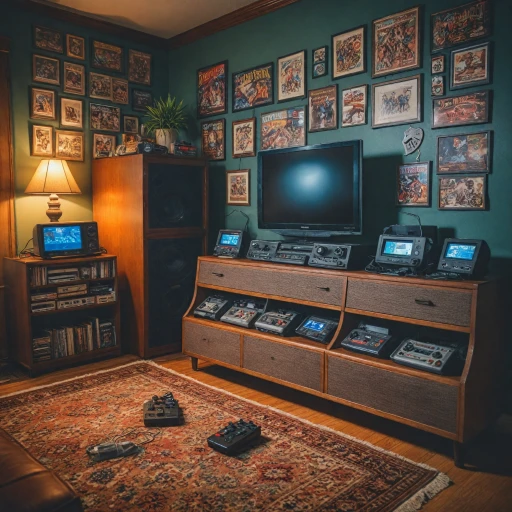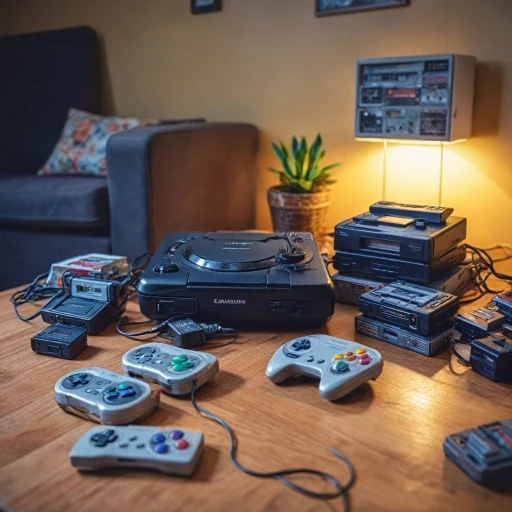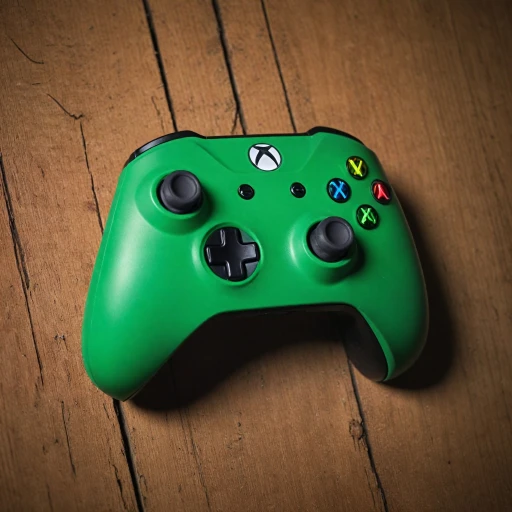
The Birth of a Handheld Revolution
The Dawn of a New Era in Handheld Gaming
The introduction of the Gameboy by Nintendo marked a pivotal moment in the world of video games. Released in 1989, this handheld console revolutionized how people played games, offering a portable gaming experience that was previously unimaginable. The Gameboy's original design was simple yet effective, featuring a monochrome screen and a compact form that made it easy to carry around.
Priced competitively, the Gameboy quickly became a must-have item for gaming enthusiasts. Its affordability and the promise of free shipping on many purchases made it accessible to a wide audience. The system's ability to play a variety of game paks, including iconic titles like Super Mario and Pokemon, contributed to its widespread appeal.
Unlike its predecessors, the Gameboy was not just a novelty; it was a game console that delivered a robust gaming experience. The success of the Gameboy paved the way for future models like the Gameboy Color and Gameboy Advance, each iteration improving upon the last in terms of screen quality and game variety.
For more insights into the impact of early gaming consoles, you might find it interesting to explore the legacy of the TurboGrafx-16 and PC Engine, which also played a significant role in shaping the gaming industry during that era.
As we delve deeper into the Gameboy's impact on the gaming industry and its cultural significance, it's clear that this handheld game system was more than just a passing trend. It laid the groundwork for future innovations, influencing everything from the Nintendo Switch to the way we perceive video games today.
Gameboy's Impact on the Gaming Industry
The Unforgettable Influence of Gameboy in Gaming
The introduction of the Gameboy by Nintendo marked a pivotal moment in the landscape of video game consoles. Unlike its predecessors, this handheld game system was revolutionary for being portable and affordable, providing gamers the ability to play anywhere, anytime. The original game boy, with its iconic gray exterior, set the stage for handheld gaming to become a mainstream phenomenon.
As a gaming console, the Gameboy's impact was profound. It brought a shift in the perception of portable gaming systems, where previously, home consoles like the Super Nintendo Entertainment System (Super NES) dominated the market. The Gameboy, by offering a diverse array of nintendo games, from the classic Super Mario to the captivating adventures of Pokemon, changed how people interacted with games. Its simple design, featuring a monochromatic screen and a game pak slot, allowed it to stand out amidst the more complex competitors of its time like Neo Geo.
A noticeable factor contributing to the Gameboy’s success was its competitive price point, making it accessible to a wider audience. With each verified purchase, consumers experienced not only the colorful world of boy nintendo titles but also the portability of gaming once deemed unimaginable. The introduction of variants like the Gameboy Color and the more compact Gameboy Pocket only broadened its appeal, prompting the evolution of subsequent models such as the Gameboy Advance.
Nintendo established a legacy whereby the game boy system became synonymous with quality handheld gaming. By pioneering this sector, the company laid the groundwork for future innovations and provided inspiration for successors like the Nintendo Switch. The decision to prioritize playability and ease-of-use over high-end specifications endeared the Gameboy to millions worldwide, cementing its place as an enduring legacy in the hearts of gamers.
For a deeper understanding of the console evolution during this era, consider exploring another monumental shift in gaming history.
Iconic Games that Defined the Gameboy Era
Top Gameboy Titles that Revolutionized Handheld Gaming
Few systems have had an impact on gaming history as substantial as the Gameboy. This classic console provided a platform for a wide array of iconic games that have left a lasting impression on players worldwide. Let's explore some of the standout titles that not only defined the Gameboy era but also helped shape the video game landscape.Perhaps the most renowned title that graced the Gameboy screen is the original Pokemon series. Released in the late 90s, these games became a cultural phenomenon, introducing players to a universe filled with pocket monsters and adventures that expanded beyond the handheld device. The engaging gameplay and trading system of Pokemon Red and Blue offered players a new dimension in gaming, proving the potential of handheld consoles to deliver complex gaming experiences.
Another noteworthy mention is Super Mario Land, Nintendo's beloved plumber taking on new adventures. This game managed to encapsulate the essence of earlier Mario titles while adapting them for the Gameboy's capabilities. With challenging levels and a nostalgic 8-bit soundtrack, Super Mario Land showcased the Gameboy's ability to handle impressive titles despite its hardware limitations.
Games such as Tetris also played a pivotal role in the Gameboy's success. Known for its addictiveness and simple mechanics, Tetris became synonymous with the Gameboy almost overnight. Its status as a classic puzzle game was solidified by its availability with the original Gameboy package, providing instant entertainment value at no additional price.
As technology advanced, the Gameboy color and Gameboy advance introduced players to more vibrant and complex games like The Legend of Zelda: Link's Awakening and Mario Kart: Super Circuit. These titles not only expanded the creative possibilities of handheld games but also showcased how upgrades such as improved screen quality and color could elevate the gaming experience.
The game consoles of today owe a significant debt to these pioneering titles that demonstrated the viability of engaging, portable gaming, paving the way for future innovations in handheld devices like the Nintendo Switch.
The Evolution of Gameboy Models
The Evolution of Gameboy Models: A Journey Through Time
The Gameboy's journey through time is a fascinating tale of innovation and adaptation. From its humble beginnings, Nintendo's handheld game console has seen numerous iterations, each bringing something new to the table. Let's explore the evolution of this iconic system.
Original Gameboy: The Classic Start
The original Gameboy, launched in 1989, was a groundbreaking device. It featured a monochrome screen and came bundled with the game Tetris, which became a massive hit. Despite its simple graphics, the Gameboy's affordability and extensive game library made it a must-have for gamers. The price point was a key factor in its widespread adoption, making it accessible to a broad audience.
Gameboy Pocket: A Sleeker Design
In 1996, Nintendo released the Gameboy Pocket. This version was more compact and lighter than its predecessor, making it even more portable. The screen was improved, offering better visibility without the need for a backlight. The Gameboy Pocket retained compatibility with the original game paks, ensuring that players could continue to enjoy their favorite games.
Gameboy Color: Adding a Splash of Color
The Gameboy Color, introduced in 1998, was a significant upgrade. It featured a color screen, which was a major advancement at the time. This model allowed players to experience games like Pokemon and Super Mario in vibrant colors, enhancing the overall gaming experience. The Gameboy Color maintained backward compatibility, allowing players to enjoy both new and old games.
Gameboy Advance: A Leap Forward
In 2001, the Gameboy Advance took the handheld gaming experience to new heights. With a larger screen and improved graphics, it offered a more immersive experience. The horizontal design was a departure from the vertical layout of previous models, providing a more ergonomic feel. The Gameboy Advance was compatible with both Gameboy and Gameboy Color games, ensuring a vast library of titles to play.
Each iteration of the Gameboy brought something new, reflecting Nintendo's commitment to innovation and understanding of the gaming market. The Gameboy's evolution not only kept it relevant but also set the stage for future handheld systems, influencing designs like the Nintendo Switch. As we look back, it's clear that the Gameboy was more than just a game console; it was a cultural phenomenon that left a lasting impact on the world of video games.
Gameboy's Cultural Significance
The Gameboy's Cultural Footprint
The Gameboy, a pioneering handheld game console, left an indelible mark on popular culture. Its influence extended beyond the realm of gaming, becoming a symbol of the 90s and a testament to Nintendo's innovation. The original Gameboy, with its monochrome screen and compact design, was more than just a gaming device; it was a cultural phenomenon.
One of the key aspects of the Gameboy's cultural significance was its accessibility. With a reasonable price point, it brought video games to a broader audience, making gaming a mainstream activity. The Gameboy's portability allowed players to enjoy games like Super Mario and Pokemon on the go, a novelty at the time that changed how people interacted with video games.
Moreover, the Gameboy's library of games, including iconic titles like Tetris and Pokemon, became cultural touchstones. These games were not just popular; they became part of the social fabric, influencing everything from fashion to music. The Gameboy's impact was so profound that it paved the way for future handheld systems, including the Nintendo Switch, which continues to blend portability with powerful gaming experiences.
As the Gameboy evolved into models like the Gameboy Color and Gameboy Advance, its cultural relevance only grew. Each iteration brought new features, such as color screens and improved graphics, keeping the system fresh and appealing to new generations of gamers. The Gameboy's legacy is evident in today's gaming landscape, where handheld gaming remains a vital part of the industry.
In essence, the Gameboy was more than just a console; it was a cultural icon that shaped the way we play and perceive video games. Its enduring legacy is a testament to Nintendo's vision and the timeless appeal of handheld gaming.












